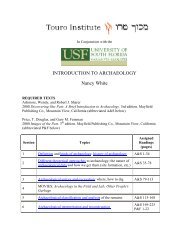In Conjunction with Cultural Anthropology - Touro Institute
In Conjunction with Cultural Anthropology - Touro Institute
In Conjunction with Cultural Anthropology - Touro Institute
You also want an ePaper? Increase the reach of your titles
YUMPU automatically turns print PDFs into web optimized ePapers that Google loves.
i. horticulture that involves the use of land for short periods followed by periods of<br />
letting the land stand idle for several years<br />
j. technology the tools and techniques by which people obtain food<br />
k. intensive cultivation using simple tools such as hoes, shovels, and animal-drawn<br />
plows<br />
l. regions <strong>with</strong> warm climates and abundant rainfall, plants, and animal life<br />
m. areas of low annual rainfall and sparse cover <strong>with</strong> low-growing desert shrubs<br />
n. areas that cover 26 percent of the earth's surface, <strong>with</strong> grasses of different types<br />
o. level or undulating treeless plains in the arctic and subarctic regions of North<br />
America, Asia, and Scandinavia<br />
p. a form of farming in which the land is prepared by cutting and burning the natural<br />
growth and in which several plots, in various stages of soil depletion, are worked in a<br />
cycle<br />
q. heavily wooded regions dominated by coniferous trees<br />
r. a subsistence technology based on gathering wild plant foods, hunting, and fishing<br />
s. areas <strong>with</strong> tall varieties of grass that tolerate wetter climates<br />
t. areas that cover stretches of southeastern Europe and Asia, <strong>with</strong> a short, hardy variety<br />
of grass<br />
u. horticulture is carried out in arid environments <strong>with</strong> the aid of simple supplemental<br />
watering techniques<br />
v. regions of cold climates near North and South poles<br />
w. cooperative food gathering where fish and small game are meat resources and plants<br />
are easily collected<br />
x. swampy coniferous forests of the northern lands south of the tundras<br />
True/False - Chapter 13: Environment, Adaption, and Subsistence<br />
True<br />
False<br />
1. Throughout most of history mixed forest have been the natural environment<br />
most densely inhabited by human beings.<br />
2. Foraging is the least adequate subsistence technology at meeting human’s<br />
nutritional needs.<br />
3. According to Lomax and Arensberg, foragers emphasize hand skills rather<br />
than tools.<br />
4. Foraging societies tend to be rather competitive and warlike in their attempts<br />
to maintain control over vital resources.<br />
5. The richer the environment of a foraging society is, the greater will be the<br />
diversity of food resources it utilizes.<br />
6. Typically slash-and-burn horticulture requires heavier investments in human<br />
labor than does dry land gardening.<br />
7. Because of their small local populations, warfare tends not to be common in
















